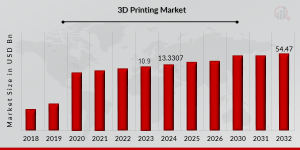3D Printing Market Set to Hit USD 54.47 Billion by 2032: MRFR Analysis
3D printing market to reach USD 54.47B by 2032, fueled by digital dentistry, R&D, and rising government support.
NEW YORK, CA, UNITED STATES, August 5, 2025 /EINPresswire.com/ -- The Future Is Now: 3D Printing Market Set to Reach USD 54.47 Billion by 2032In an era defined by innovation and customization, 3D printing—also known as additive manufacturing—has emerged as one of the most transformative technologies across various industries. According to the latest analysis by Market Research Future (MRFR), the global 3D printing market, valued at USD 10.9 billion in 2023, is forecasted to reach a staggering USD 54.47 billion by 2032, expanding at a compound annual growth rate (CAGR) of 19.24% from 2024 to 2032.
This dynamic growth is being propelled by significant technological advances, rising demand in digital dentistry, prototyping needs across sectors, and considerable government investments aimed at accelerating innovation. Let’s explore what’s fueling this growth and how different segments of the 3D printing market are evolving.
Key Growth Drivers
1. Surging Demand in Digital Dentistry: One of the most promising applications of 3D printing lies in the field of digital dentistry. From creating custom dental implants and crowns to full dentures and surgical guides, 3D printing enables faster production with high precision. Dentists and orthodontists are increasingly turning to this technology to streamline workflows and reduce patient turnaround time, which is playing a major role in the market’s growth.
2. Government Investments and Initiatives: Governments across the globe are investing heavily in 3D printing projects, recognizing its potential in manufacturing, defense, healthcare, and education. For instance, national initiatives to boost smart manufacturing and digital transformation have included funding for research, infrastructure development, and public-private partnerships in additive manufacturing.
3. Customization and Prototyping Needs: The demand for customized solutions and rapid prototyping has seen exponential growth, especially in sectors like automotive, aerospace, healthcare, and consumer goods. 3D printing allows businesses to reduce the time and cost associated with developing prototypes, leading to faster product development cycles and more innovative designs.
Get a FREE Sample Report@ https://www.marketresearchfuture.com/sample_request/1031
Segmental Analysis
1. Hardware Segment Leads the Market: The hardware component—which includes 3D printers, print heads, and other accessories—accounts for the largest revenue share at 35%. With the increasing adoption of industrial-grade 3D printers in manufacturing and healthcare, this segment continues to drive substantial market value. New innovations in printing technology and faster processing speeds are further enhancing the appeal of 3D hardware.
2. Software: The Fastest-Growing Category: While hardware takes the lead in revenue, software is the fastest-growing category in the 3D printing ecosystem. Advanced modeling tools, simulation software, and workflow management solutions are being developed to enhance the accuracy and efficiency of printing operations. This includes AI-driven design platforms and cloud-based monitoring tools that offer real-time data analysis and control.
3. Prototyping Dominates Application Use: Prototyping remains the primary application, accounting for an astounding 70.4% of the market income. This includes functional prototypes, design validation models, and pilot testing components used across industries like aerospace, automotive, and electronics. The ability to create cost-effective, on-demand prototypes significantly reduces development time, driving continued dominance in this category.
4. Industrial 3D Printers Outperform: Industrial 3D printers are the backbone of commercial additive manufacturing. These high-performance machines are used for metal, composite, and polymer fabrication and are essential in sectors that require complex geometries and durable materials. The industrial printer segment commands the majority of revenue generation, thanks to its wide-scale applications and higher price points.
Material Insights
1. Metal: The Leading Material Category
Metals such as titanium, stainless steel, and aluminum alloys are widely used in aerospace, automotive, and medical implants, making them the top revenue-generating material category in the market. Metal 3D printing, often executed through techniques like selective laser melting (SLM) or electron beam melting (EBM), allows for lightweight, high-strength parts with reduced waste.
2. Polymers: Fastest Growing Material
Thanks to rapid advancements in research and development, polymers are quickly gaining popularity. Materials such as PLA, ABS, PETG, and resins are not only cost-effective but also highly versatile for various applications—from consumer products to low-volume medical devices. Innovations in bio-based and high-performance polymers are opening new frontiers for growth.
Buy Full Research Report@ https://www.marketresearchfuture.com/checkout?currency=one_user-USD&report_id=1031
Regional Landscape
Though North America continues to be a dominant force, driven by innovation hubs in the U.S. and Canada, emerging economies in Asia-Pacific—especially China, Japan, South Korea, and India—are fast catching up. Europe, too, holds a significant share, with major research investments and active involvement in sustainable manufacturing practices.
Challenges to Consider
Despite the strong growth trajectory, the 3D printing market faces several challenges:
High initial costs of industrial 3D printers and materials
Lack of standardization in materials and processes
Limited technical expertise and workforce training
Intellectual property concerns in digital file sharing
However, ongoing investment in education, evolving policy frameworks, and the democratization of 3D printing tools are gradually mitigating these barriers.
The Road Ahead
The global 3D printing market is well on its way to becoming a cornerstone of modern manufacturing and design. As industries push the boundaries of customization, precision, and sustainability, additive manufacturing will continue to unlock new possibilities.
Key opportunities lie in:
Healthcare: personalized prosthetics, bioprinting tissues
Construction: 3D-printed homes and bridges
Aerospace: lightweight components and satellite parts
Education and R&D: expanding 3D printing curriculum and labs
With continuous technological innovations and rising cross-sector adoption, the dream of a fully digitized, on-demand production economy is within reach.
From healthcare to aerospace, the transformative potential of 3D printing is reshaping the industrial landscape. With the market poised to grow at a CAGR of 19.24% and reach over USD 54 billion by 2032, the journey ahead is one of immense opportunity. As material sciences evolve, software becomes smarter, and hardware more accessible, businesses that embrace additive manufacturing will lead the charge into the future of production.
Related Trending Research Report@
CCTV Market- https://www.marketresearchfuture.com/reports/cctv-market-677
Biosensors Development and Demand Market- https://www.marketresearchfuture.com/reports/global-biosensors-market-833
DRAM Market- https://www.marketresearchfuture.com/reports/dram-market-978
Spatial Light Modulator Market- https://www.marketresearchfuture.com/reports/spatial-light-modulator-market-1721
Smart Building Market- https://www.marketresearchfuture.com/reports/smart-building-market-1860
E-Paper Display Market- https://www.marketresearchfuture.com/reports/e-paper-display-market-2189
Active Electronic Components Market- https://www.marketresearchfuture.com/reports/active-electronic-components-market-2284
Public Cloud Market- https://www.marketresearchfuture.com/reports/public-cloud-market-2291
Machine Control System Market- https://www.marketresearchfuture.com/reports/machine-control-system-market-2384
Sagar Kadam
Market Research Future
+1 628-258-0071
email us here
Visit us on social media:
LinkedIn
Facebook
X
Legal Disclaimer:
EIN Presswire provides this news content "as is" without warranty of any kind. We do not accept any responsibility or liability for the accuracy, content, images, videos, licenses, completeness, legality, or reliability of the information contained in this article. If you have any complaints or copyright issues related to this article, kindly contact the author above.
MTC Adds Cosmetic Surgery & Hair Transplants to 5-Year Alliance with DentSpa, Istanbul, Turkey
New General Manager Named at Embassy Suites by Hilton Nashville at Vanderbilt
Fintech in Transition: EMBank Chairperson Ekmel Çilingir Offers a 2025 Outlook on the Sector’s Maturation
Więcej ważnych informacji
 Jedynka Newserii
Jedynka Newserii

 Jedynka Newserii
Jedynka Newserii

Handel

1 października ruszy w Polsce system kaucyjny. Część sieci handlowych może nie zdążyć z przygotowaniami przed tym terminem
Producenci, sklepy i operatorzy systemu kaucyjnego mają niespełna dwa miesiące na finalizację przygotowań do jego startu. Wówczas na rynku pojawią się napoje w specjalnie oznakowanych opakowaniach, a jednostki handlu powinny być gotowe na ich odbieranie. Część z nich jest już do tego przygotowana, część ostrzega przed ewentualnymi opóźnieniami. Jednym z ważniejszych aspektów przygotowań na te dwa miesiące jest uregulowanie współpracy między operatorami, których będzie siedmiu, co oznacza de facto siedem różnych systemów kaucyjnych.
Ochrona środowiska
KE proponuje nowy cel klimatyczny. Według europosłów wydaje się niemożliwy do realizacji

Komisja Europejska zaproponowała zmianę unijnego prawa o klimacie, wskazując nowy cel klimatyczny na 2040 roku, czyli redukcję emisji gazów cieplarnianych o 90 proc. w porównaniu do 1990 rok. Jesienią odniosą się do tego kraje członkowskie i Parlament Europejski, ale już dziś słychać wiele negatywnych głosów. Zdaniem polskich europarlamentarzystów już dotychczas ustanowione cele nie zostaną osiągnięte, a europejska gospodarka i jej konkurencyjność ucierpi na dążeniu do ich realizacji względem m.in. Stanów Zjednoczonych czy Chin.
Handel
Amerykańskie indeksy mają za sobą kolejny wzrostowy miesiąc. Druga połowa roku na rynkach akcji może być nerwowa

Lipiec zazwyczaj jest pozytywnym miesiącem na rynkach akcji i tegoroczny nie był wyjątkiem. Amerykańskie indeksy zakończyły go na plusie, podobnie jak większość europejskich. Rynki Starego Kontynentu nie przyciągają jednak już kapitału z taką intensywnością jak w pierwszej części roku. Z drugiej strony wyceny za oceanem po kolejnych rekordach są już bardzo wysokie, a wpływ nowego porządku celnego narzuconego przez Donalda Trumpa – na razie trudny do przewidzenia. W najbliższym czasie na rynkach można się spodziewać jeszcze większej zmienności i nerwowości, ale dopóki spółki pokazują dobre wyniki, przesłanek do zmiany trendu na spadkowy nie ma.
Partner serwisu
Szkolenia

Akademia Newserii
Akademia Newserii to projekt, w ramach którego najlepsi polscy dziennikarze biznesowi, giełdowi oraz lifestylowi, a także szkoleniowcy z wieloletnim doświadczeniem dzielą się swoją wiedzą nt. pracy z mediami.



![Nestlé w Polsce podsumowuje wpływ na krajową gospodarkę. Firma wygenerowała 0,6 proc. polskiego PKB [DEPESZA]](https://www.newseria.pl/files/1097841585/fabryka-nesquik_1,w_85,r_png,_small.png)




.gif)

 |
| |
| |
|